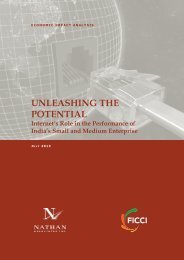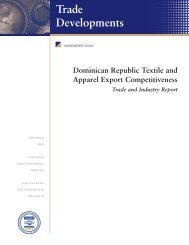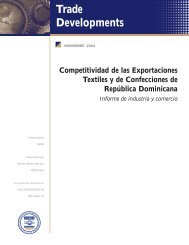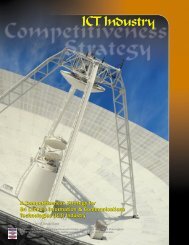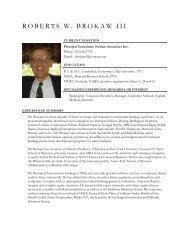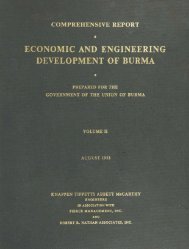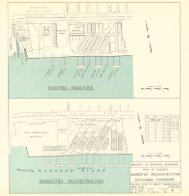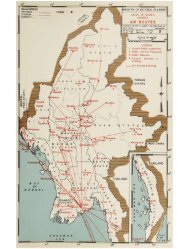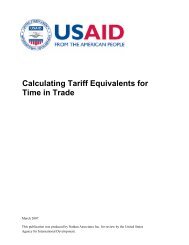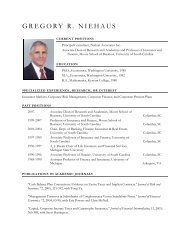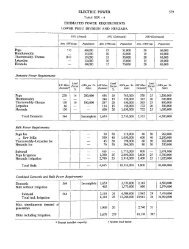Putting it to Work in Developing Countries - Nathan Associates
Putting it to Work in Developing Countries - Nathan Associates
Putting it to Work in Developing Countries - Nathan Associates
Create successful ePaper yourself
Turn your PDF publications into a flip-book with our unique Google optimized e-Paper software.
4. Some FDI already flows <strong>to</strong> every part of<br />
the world, but <strong>it</strong> is not evenly distributed.<br />
Ch<strong>in</strong>a’s overwhelm<strong>in</strong>g appeal, India’s<br />
potentially huge appeal, and the end of<br />
the Multifibre Arrangement of global<br />
quotas that long diverted FDI <strong>to</strong> poorer<br />
develop<strong>in</strong>g countries may all exacerbate<br />
this unevenness. All countries, but<br />
especially those <strong>in</strong> sub-Saharan Africa and<br />
Middle East/North Africa, need <strong>to</strong> look<br />
carefully at what attracts FDI <strong>to</strong> their<br />
economies—and what repels <strong>it</strong>.<br />
5. The sec<strong>to</strong>ral dest<strong>in</strong>ations of FDI flows <strong>in</strong><br />
the develop<strong>in</strong>g world have changed<br />
def<strong>in</strong><strong>it</strong>ively. Though no longer ascendant, 6.<br />
the manufactur<strong>in</strong>g-related FDI that<br />
dom<strong>in</strong>ated the 1980s and early 1990s is<br />
still important. The rise of the “global<br />
fac<strong>to</strong>ry” will cont<strong>in</strong>ue <strong>to</strong> generate<br />
efficiency-seek<strong>in</strong>g FDI opportun<strong>it</strong>ies <strong>to</strong><br />
manufacture parts and components for<br />
<strong>in</strong>ternational production networks, but<br />
services-related FDI now accounts for<br />
most <strong>in</strong>flows, and will cont<strong>in</strong>ue <strong>to</strong> do so.<br />
Most services-related FDI is still marketseek<strong>in</strong>g,<br />
particularly <strong>in</strong>vestment <strong>in</strong> public<br />
util<strong>it</strong>ies or f<strong>in</strong>ance, and these sec<strong>to</strong>rs still<br />
present vast possibil<strong>it</strong>ies. But, at the same<br />
time, efficiency-seek<strong>in</strong>g activ<strong>it</strong>ies such as<br />
export-oriented bus<strong>in</strong>ess support services<br />
are the fastest grow<strong>in</strong>g segment, and this<br />
expansion will accelerate.<br />
The attributes that attract FDI <strong>to</strong> a host<br />
country are well-known and straightforward.<br />
They beg<strong>in</strong> w<strong>it</strong>h a set of economiccommercial<br />
fac<strong>to</strong>rs that characterize any<br />
Foreign Direct Investment and the Costa Rica Brand<br />
How did Costa Rica become the <strong>to</strong>p desti- and sociopol<strong>it</strong>ical advantages. This brand<br />
nation for FDI <strong>in</strong> Central America In the has proved compell<strong>in</strong>g <strong>to</strong> foreign <strong>in</strong>ves<strong>to</strong>rs<br />
1970s and 1980s, when much of the region such as Intel and Procter & Gamble. Intel<br />
was com<strong>in</strong>g <strong>to</strong> grips w<strong>it</strong>h the lim<strong>it</strong>ations of located a $300 million semiconduc<strong>to</strong>r<br />
the import-subst<strong>it</strong>ution development assembly production center <strong>in</strong> Costa Rica,<br />
model, Costa Rica was diversify<strong>in</strong>g <strong>it</strong>s after consider<strong>in</strong>g Brazil, Chile, and Mexico;<br />
export base and attract<strong>in</strong>g U.S. <strong>in</strong>vestment. and Procter & Gamble established a shared<br />
Like many develop<strong>in</strong>g countries, <strong>it</strong> used free services operation there. Asked “why Costa<br />
trade zones (FTZ), a system established <strong>in</strong> Rica” foreign <strong>in</strong>ves<strong>to</strong>rs c<strong>it</strong>e the country’s<br />
the 1980s and based around <strong>in</strong>dustrial relatively cheap and tra<strong>in</strong>able workers—a<br />
parks. A favorable <strong>in</strong>vestment climate key aspect of the brand—as well as pol<strong>it</strong>ical<br />
helped the zones <strong>to</strong> flourish. In 1984, Costa and social stabil<strong>it</strong>y, preferential access and<br />
Rica ga<strong>in</strong>ed preferential access <strong>to</strong> U.S. mar- time-zone proxim<strong>it</strong>y <strong>to</strong> the Un<strong>it</strong>ed States,<br />
kets when <strong>it</strong> ratified the Caribbean Bas<strong>in</strong> and export-oriented <strong>in</strong>frastructure. CINDE<br />
Trade Partnership Act. It also ratified several has vigorously promoted <strong>in</strong>ward FDI <strong>in</strong> key<br />
bilateral <strong>in</strong>vestment treaties and provided sec<strong>to</strong>rs—high technology (e.g., electronics,<br />
other <strong>in</strong>ves<strong>to</strong>r <strong>in</strong>centives. The Costa Rican medical devices), services (e.g., shared serv-<br />
Investment Board (CINDE), a private non- ices, call centers), and <strong>to</strong>urism. Throughout<br />
prof<strong>it</strong> organization founded <strong>in</strong> 1982, has the 1990s, <strong>in</strong>ward FDI grew impressively,<br />
done much <strong>to</strong> boost the amount and quali- peak<strong>in</strong>g at $620 million <strong>in</strong> 1999, lay<strong>in</strong>g the<br />
ty of efficiency-seek<strong>in</strong>g FDI enter<strong>in</strong>g the foundation for Costa Rica’s development<br />
country. In “brand<strong>in</strong>g” Costa Rica <strong>it</strong> has success <strong>to</strong> date. In 2002, FDI was $642<br />
drawn on the country’s location, labor, million.<br />
84



